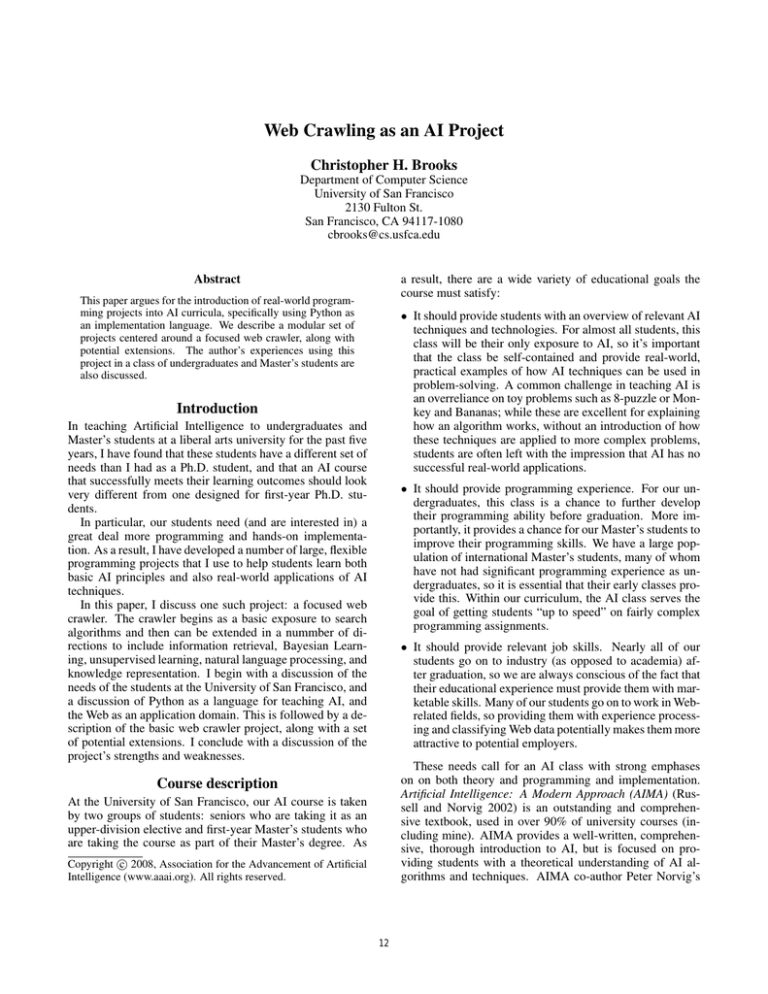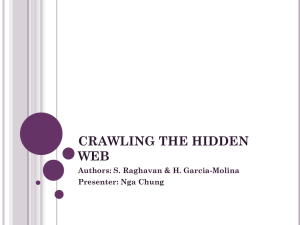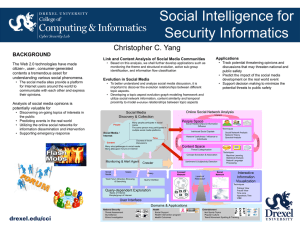
Web Crawling as an AI Project
Christopher H. Brooks
Department of Computer Science
University of San Francisco
2130 Fulton St.
San Francisco, CA 94117-1080
cbrooks@cs.usfca.edu
Abstract
a result, there are a wide variety of educational goals the
course must satisfy:
This paper argues for the introduction of real-world programming projects into AI curricula, specifically using Python as
an implementation language. We describe a modular set of
projects centered around a focused web crawler, along with
potential extensions. The author’s experiences using this
project in a class of undergraduates and Master’s students are
also discussed.
• It should provide students with an overview of relevant AI
techniques and technologies. For almost all students, this
class will be their only exposure to AI, so it’s important
that the class be self-contained and provide real-world,
practical examples of how AI techniques can be used in
problem-solving. A common challenge in teaching AI is
an overreliance on toy problems such as 8-puzzle or Monkey and Bananas; while these are excellent for explaining
how an algorithm works, without an introduction of how
these techniques are applied to more complex problems,
students are often left with the impression that AI has no
successful real-world applications.
Introduction
In teaching Artificial Intelligence to undergraduates and
Master’s students at a liberal arts university for the past five
years, I have found that these students have a different set of
needs than I had as a Ph.D. student, and that an AI course
that successfully meets their learning outcomes should look
very different from one designed for first-year Ph.D. students.
In particular, our students need (and are interested in) a
great deal more programming and hands-on implementation. As a result, I have developed a number of large, flexible
programming projects that I use to help students learn both
basic AI principles and also real-world applications of AI
techniques.
In this paper, I discuss one such project: a focused web
crawler. The crawler begins as a basic exposure to search
algorithms and then can be extended in a nummber of directions to include information retrieval, Bayesian Learning, unsupervised learning, natural language processing, and
knowledge representation. I begin with a discussion of the
needs of the students at the University of San Francisco, and
a discussion of Python as a language for teaching AI, and
the Web as an application domain. This is followed by a description of the basic web crawler project, along with a set
of potential extensions. I conclude with a discussion of the
project’s strengths and weaknesses.
• It should provide programming experience. For our undergraduates, this class is a chance to further develop
their programming ability before graduation. More importantly, it provides a chance for our Master’s students to
improve their programming skills. We have a large population of international Master’s students, many of whom
have not had significant programming experience as undergraduates, so it is essential that their early classes provide this. Within our curriculum, the AI class serves the
goal of getting students “up to speed” on fairly complex
programming assignments.
• It should provide relevant job skills. Nearly all of our
students go on to industry (as opposed to academia) after graduation, so we are always conscious of the fact that
their educational experience must provide them with marketable skills. Many of our students go on to work in Webrelated fields, so providing them with experience processing and classifying Web data potentially makes them more
attractive to potential employers.
These needs call for an AI class with strong emphases
on on both theory and programming and implementation.
Artificial Intelligence: A Modern Approach (AIMA) (Russell and Norvig 2002) is an outstanding and comprehensive textbook, used in over 90% of university courses (including mine). AIMA provides a well-written, comprehensive, thorough introduction to AI, but is focused on providing students with a theoretical understanding of AI algorithms and techniques. AIMA co-author Peter Norvig’s
Course description
At the University of San Francisco, our AI course is taken
by two groups of students: seniors who are taking it as an
upper-division elective and first-year Master’s students who
are taking the course as part of their Master’s degree. As
c 2008, Association for the Advancement of Artificial
Copyright Intelligence (www.aaai.org). All rights reserved.
12
lent domain for several reasons: students are familiar with
it, there is a huge source of freely available data, and there is
a large job market for students who have experience working
with Web data. The success of the AI and the Web track at
AAAI would indicate that there is a wide variety of research
being developed in this area as well.
Paradigms of AI Programming (Norvig 1991) is an excellent text that describes the issues involved in building nontrivial AI programs, but focuses primarily on historically interesting problems such as Eliza (Weizenbaum 1966) and
Mycin (Buchanan and Shortliffe 1984).
I have found that our students learn this material best by
doing; much of it is abstract enough, or sufficiently separate
from their past experience, that just presenting it in lecture
and giving pencil-and-paper homework problems is not sufficient for students to grasp the material. They need to actually implement it in order to truly understand the details.
In order to fit the needs of my students, I have supplemented
AIMA with self-developed material describing how to apply
these techniques to real-world problems.
The class follows a fairly typical structure for an introductory AI course. We begin with a discussion of agency, followed by search, then knowledge representation and logic,
followed by probability and Bayesian reasoning. Learning
is integrated through the curriculum, rather than treated separately; for example, decision trees are presented immediately after learning about propositional inference as a means
of constructing rulesets, and Bayesian learning is presented
in conjunction with belief networks. The crawler described
in this paper is presented in conjunction with search. Students have approximately two weeks to complete it. Later in
the semester, extensions such as Bayesian classification are
added in.
Wikipedia
I typically have students start out by working with a locallyhosted mirror of Wikipedia. This has several advantages: of
reasons:
• Pages are all uniformly constructed, contain valid HTML,
and link to other Wikipedia pages. This makes it much
easier for students to parse them and extract links, so that
they can spend time on AI-related tasks, rather than dealing with malformed URLs or handling parser exceptions.
• Pages have a large amount of text, all in a single language, on a variety of subjects. This makes it appropriate for tasks involving topic detection, search, or natural
language.
• Hosting a mirror locally allows students to avoid dealing
with DNS problems, 404 errors, or accidentally crawling
a remote site that excludes robots and spiders. 1
Focused Web Crawler
The Web crawler is the first “large” project I give the students. It comes as we are discussing search, and serves
several needs: it gives students a hands-on introduction to
search algorithms, it provides a real-world application of
search, and it also scales up programming difficulty from
previous assignments, which are small tasks designed to
help them learn Python.
In this project, students implement a focused Web crawler
as a way of learning about different search algorithms 2 .
This is a program that starts at a given Web page and
searches outward from this page, looking for other pages
that meet a user’s needs or match a search query. In the basic
project, students crawl a locally-hosted copy of Wikipedia.
To begin, they are asked to build a crawler that can start at a
given URL and select a fixed number of pages.
Students are provided with a basic crawler as a starting
point. This is a small piece of Python code that can fetch
a webpage, instantiate a Wikipage class to hold it, and enqueue each of the URLs (outward links) in the page. The
Wikipage class contains code to extract text from HTML and
split it into individual words and capture all outward links.
The crawler uses a Scorer object to determine where to
place each page in a search queue (implemented as a heap).
By using depth in the search tree as a score and using either
a min-heap or a max-heap, students can implement breadthfirst or depth-first search. One nice feature of this architecture is that students see the separation between the search
Python as an AI Language
Python has received a great deal of attention as an introductory language (Guzdial 2005; Downey 2007); in my experience, it has also proved to be an excellent language for a
project-based AI course for several reasons:
• It has a clean, readable syntax that looks very much like
pseudocode. This makes the mapping from description
to implementation much simpler. It is also easy to learn;
students who have used Java, C#, or C++ can pick up the
basics in a couple of lectures.
• It is cross-platform, freely available, and easy for students
to set up.
• It allows for the ability to use a number of different
programming styles, such as imperative, object-oriented,
functional, and applicative. It has much of the functionality of Lisp (except for Lisp’s macros), such as anonymous and higher-order functions, functions as first-class
objects, mapping and list operations, and closures, but
with a much shallower learning curve.
• It has extensive libraries for working with networks,
HTML, XML, RDF, and other relevant technologies.
• It is a very high-level language, which allows for the rapid
prototyping and development of programs. This makes it
possible for students to complete relatively complex programs in a week or two.
1
Several years ago, USF access to Slashdot was blocked for
a couple of days after a student ran his crawler on their site, in
violation of their Robot Exclusion policy.
2
The project description and provided code can be found here:
Web Focus
Many of the projects in my class have some sort of Weboriented application. The web has proved to be an excel-
http://www.cs.usfca.edu/∼brooks/F07classes/cs662/assignments/assignment3.html
13
def crawl(self, nGoalpages=10, ntotalPages=500, threshold=0.5,
startURL, scorer=None) :
pagesFound = 0
ntotalPages = 0
startpage = wikipage.Wikipage(startURL)
scorer.score(startpage)
heappush(self.queue, startpage)
while pagesFound < npages and pagesCrawled < ntotalPages:
nextpage = heappop(self.queue)
if nextpage.score > threshold :
self.pages.append(newpage)
pagesFound += 1
for link in nextpage.outwardLinks :
newpage = wikipage.Wikipage(base+link)
scorer.score(newpage)
heappush(self.queue, newpage)
return self.pages
to construct a Naive Bayes classifier. This classifier provides
a score for each crawled page, which is its probability of being “liked.” The Bayesian scorer also uses a modality in
which the user provides a set of documents she likes without explicitly describing what she is looking for in terms of
a search query. This provides students with the opportunity
to do an experimental comparison: they collect documents
with each scorer, examine the top N documents by hand,
and determine what fraction of the documents truly met the
search criteria. They also examine false positives, and try to
identify why those pages were scored incorrectly. This often helps students to identify weaknesses of each algorithm,
such as problems with synonymy or polysemy, not working
with document structure, and the presence of noise words,
and gives them a chance to suggest improvements.
A nice thing about this project is that I can return to it at
later points in the semester, or in related classes, and have
students extend it in different ways in order to learn about
other AI or Web-related topics. Some extensions include:
Figure 1: Python code implementing a generic search function for the web crawler.
architecture and the specific algorithm being implemented.
While they change the scoring function for each task, the
crawl method remains unchanged. This illustrates the
power of reusable code, and of separating knowledge from
algorithm, as is discussed in AIMA.
Students are then asked to implement a closed list by storing a dictionary of previously visited URLs and removing
them from all outwardLinks.
Once this basic architecture is built, students focus on the
problem of searching for pages that meet a user’s needs,
through the implementation of a series of progressively complex Scorer classes. The scorer provides a metric of how
well a particular page matches a user’s information needs.
Pages with high scores have their outward links placed to
the front of the queue; low-scoring pages have their outward
links enqueued at the rear. This provides students with exposure to heuristic search.
The first Scorer the students implement is a keyword
scorer: the user provides keywords indicating their search
need, and the scorer counts their presence or absence. Pages
are scored based on the fraction of keywords they contain;
pages with a high score have their outward links placed at
the front of the queue. This provides students with a chance
to work with Boolean queries, and also an opportunity to
discuss the challenge of satisfying a user’s needs with a keyword query, given that most keyword searches contain only
a few terms.
The students then implement a more complex scorer: the
TFIDF scorer. The user provides the crawler with a set of
pages that conform to her interests, and the crawler must
find similar pages. Each page is treated as a vector, with
TFIDF (Baeza-Yates and Ribeiro-Neto 1999) used to compute term weights. Cosine similarity is used to measure the
similarity between crawled pages and pages of interest, and
provide a score for each page. Students get the opportunity to learn about the idea of documents as vectors, are exposed to basic IR methods for comparing documents, and
are forced to think about an alternative modality for meeting
a user’s information needs: “find me more things like this”
as opposed to “find me documents that contain these words.”
Later in the semester when we reach probabilistic reasoning, students implement a Bayesian scorer. The user provides a set of “liked” and “not liked” pages, which are used
• Natural Language Processing.
Students extend the
crawler to use the NLTK toolkit (Loper, Klein, and Bird
2007) to perform chunking on Wikipedia pages, extract
noun phrases, and then perform Named Entity Recognition. Students then construct rules that are used to populate a small knowledge base. For example, we often
work with The Simpsons as a domain, and students extract knowledge from Wikipedia to automatically learn
family relationships between the different characters.
• Document clustering. Students use the crawler to collect
a set of Wikipedia pages and then cluster them according
to topic, using the vector model described above and a
k-nearest neighbor algorithm.
• FOAF search. Students modify the parser to process
FOAF (Friend-of-a-Friend) (Brickley and Miller 2006)
files. FOAF is an RDF dialect that describes a person and
provides references to their friends’ FOAF files. Students
start with a given FOAF file and crawl outward, building
of a networked representation of the relationships in the
class. I also ask them to solve “Kevin Bacon” sorts of
problems: find the shortest route between two people that
involves a third person. The resulting model can then be
emitted as RDF and used as input for an ontology editor
such as SWOOP (Kalyanpur, Parsia, and Hendler 2005)
or Protege (Noy et al. 2001). Students get experience
working with RDF, constructing a simple ontology, and
working with small-world networks.
• Learning user preferences. Students introduce a feedback
loop into the crawler. After collecting a set of documents,
the user is given the chance to evaluate each document
and rate it as “liked” or “not liked”. This data is then fed
into a classifer (I typically have students use an off-theshelf tool such as SV Mlight (Joachims 1999)) to learn a
model of user preferences. This model is then used in the
next round of heuristic search; documents that are more
likely to be “liked” are placed to the front of the search
queue.
• Performance and algorithmic analysis; students are given
14
a set of pages or topics to discover and measure the performance of different search strategies and scorers. This
can be used to measure the number of pages visited and
enqueued with depth-first and breadth-first search, as a
way to evaluate the precision and recall of different classifiers, and as a way for students to get some exposure to
experimental design and hypothesis testing.
• Crawling “in the wild.” Students modify their crawler to
work on any web pages, rather than just Wikipedia. This
produces a host of problems for them to consider, including dealing with robots.txt, handling malformed HTML
and Javascript, handling other document types such as
Word, PDF and Flash, broken URLs, 404s, spider traps,
DNS resolution, working with multiple threads, and detecting non-English pages. This is an excellent extension
for students who want experience either with networking
protocols or with advanced Python. There are also several
AI approaches to detecting language, including Bayesian
classification or n-gram based prediction.
typically give a small assignment where students implement
the basic uninformed and heuristic search algorithms on a
toy problem such as fox-and-chickens, and then follow this
with the crawler.
Discussion
References
Conclusion
This paper has presented an argument for the incorporation
of programming projects with a real-world focus into an introductory AI class, the advantages of Python as an AI programming language, and a detailed description of a modular
focused web crawler project.
Further work includes the continued development of the
crawler, along with the further development of other course
projects in progress, including a Bayesian spam classifier,
tools for unsupervised clustering of email, a genetic algorithm for solving constraint and scheduling problems, and
an agent that uses reinforcement learning to help place products in an e-commerce setting.
I’ve used different versions of the focused web crawler for
the past five years in my AI class, with a great deal of success. The project has several features that make it work well
as a first large assignment:
• It’s a modular project; pieces can be added or removed
depending upon the focus of the course in a given year.
For example, in Fall 2007, I wanted to spend more time
talking about Natural Language Processing, and so I had
the students extend the scorer to use an off-the-shelf noun
phrase chunker to extract relational information.
• It provides students with exposure to real-world applications of a variety of AI algorithms. They see both how
these algorithms can be used to solve complex problems,
and also how the “vanilla” versions of these algorithms
can struggle when faced with the messiness of real-world
datasets.
• It can be a jumping-off point for directed studies or student research projects. I have had students develop more
scalable versions of the crawler for processing online
datasets (Brooks et al. 2006; Brooks and Montanez 2006)
and for constructing personalized assistants for discovering research papers (Brooks et al. 2007).
• It forces students to think carefully about the details of
these techniques and how they should be implemented.
For example, why is a heap more efficient than a list?
Why is a dictionary more useful than a list for representing a closed list? The project is just large enough that poor
implementation choices will lead to long running times.
This also provides an opportunity to talk about profiling,
unit testing, and similar topics normally treated in isolation in a software engineering class.
One weakness of the project is that it’s not clear how to
integrate A* search; it’s not obvious how to construct an admissible (and interesting) heuristic in this setting. This can
be a challenge for instructors using AIMA, as A* is typically the topic covered directly after uninformed search. I
Baeza-Yates, R., and Ribeiro-Neto, B. 1999. Modern Information Retrieval. New York: Addison-Wesley.
Brickley, D., and Miller, L. 2006. FOAF Vocabulary Specification. XMLNS Specification. Available at:
http://xmlns.com/foaf/0.1/.
Brooks, C. H., and Montanez, N. 2006. Improved Annotation of the Blogosphere via Autotagging and Hierarchical Clustering. In Proceedings of the 15th International
World Wide Web Conference (WWW-2006). Edinburgh,
UK: ACM Press.
Brooks, C. H.; Agarwal, M.; Endo, J.; King, R.; Montanez,
N.; and Stevens, R. 2006. Slashpack: An Integrated Toolkit
for Gathering and Filterng Hypertext Data. In Proceedings
of the 21st National Conference on Artificial Intelligence
(AAAI-06).
Brooks, C. H.; Fang, Y.; Joshi, K.; Okai, P.; and Zhou,
X. 2007. Citepack: An Autonomous Agent for Discovering and Integrating Research Sources. In Proceedings of
the 2007 AAAI Workshop on Information Integration on the
Web. Vancouver: AAAI Press.
Buchanan, B. G., and Shortliffe, E. H., eds.
1984.
Rule-Based Expert Systems: The MYCIN
Experiments
of
the
Stanford
Heuristic
Programming Project.
AAAI Press.
Available at
http://www.aaaipress.org/Classic/Buchanan/buchanan.html.
Downey, A. 2007. How To Think Like a (Python)
Programmer.
Green Tea Press.
Available at:
http://www.greenteapress.com/thinkpython/.
Guzdial, M. 2005. Introduction to Computing and Programming in Python, A Multimedia Approach. Prentice
Hall.
Joachims, T. 1999. Making Large-scale SVM Learning
Practical. In Schlkopf, B.; Burges, C.; and Smola, A., eds.,
Advances in Kernel Methods - Support Vector Learning.
MIT Press.
15
Kalyanpur, A.; Parsia, B.; and Hendler, J. 2005. A Tool for
Working with Web Ontologies. Proceedings of the International Journal on Semantic Web and Information Systems
1(1).
Loper, E.; Klein, E.; and Bird, S. 2007. Introduction to
Natural Language Processing. self-published. See also:
http://nltk.sourceforge.net/index.php/Book.
Norvig, P. 1991. Paradigms of Artificial Intelligence Programming: Case Studies in Common Lisp. Morgan Kauffman.
Noy, N. F.; Sintek, M.; Decker, S.; Crubezy, M.; Fergerson, R. W.; and Musen, M. A. 2001. Creating Semantic
Web Contents with Protege-2000. IEEE Intelligent Systems 16(2):60–71.
Russell, S., and Norvig, P. 2002. Artifical Intelligence: A
Modern Approach. Prentice Hall, 2nd edition.
Weizenbaum, J. 1966. ELIZA–A Computer Program For
the Study of Natural Language Communication Between
Man and Machine. Communications of the ACM 9(1).
16




